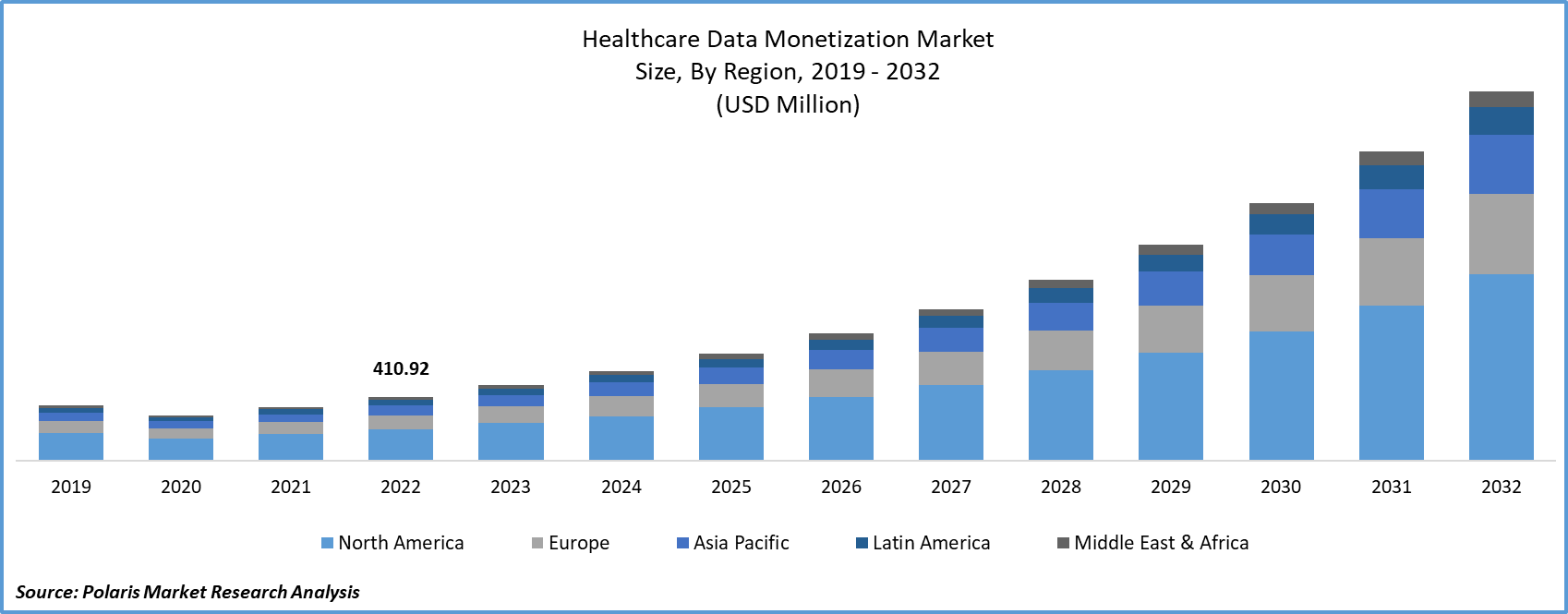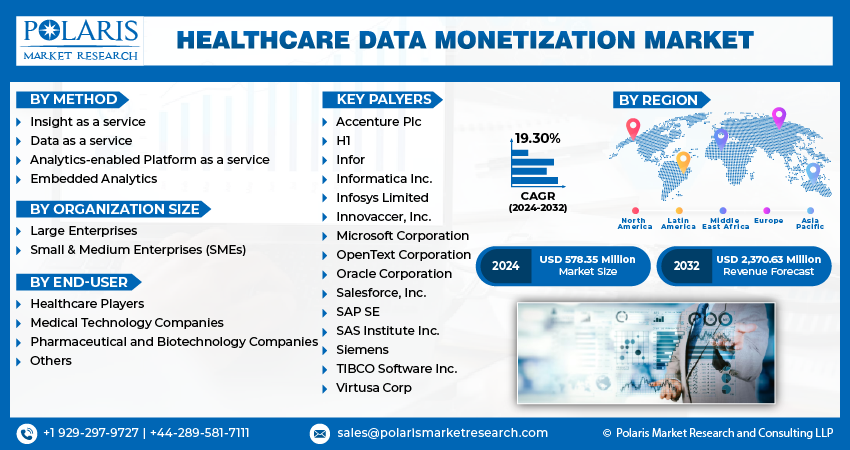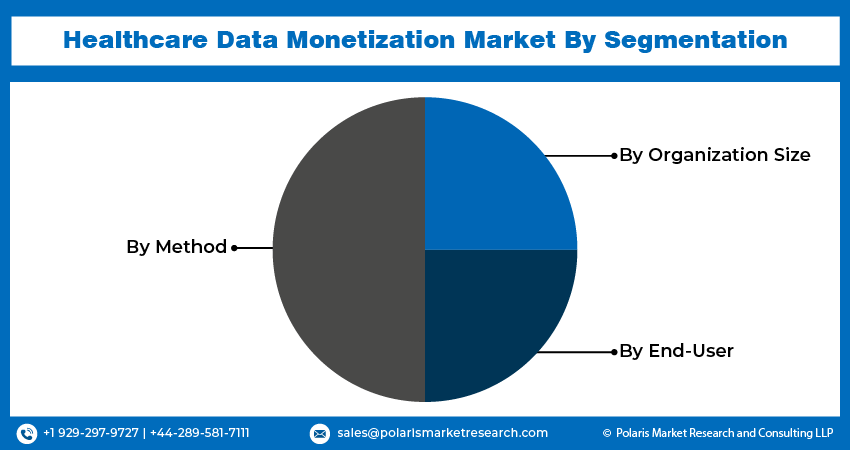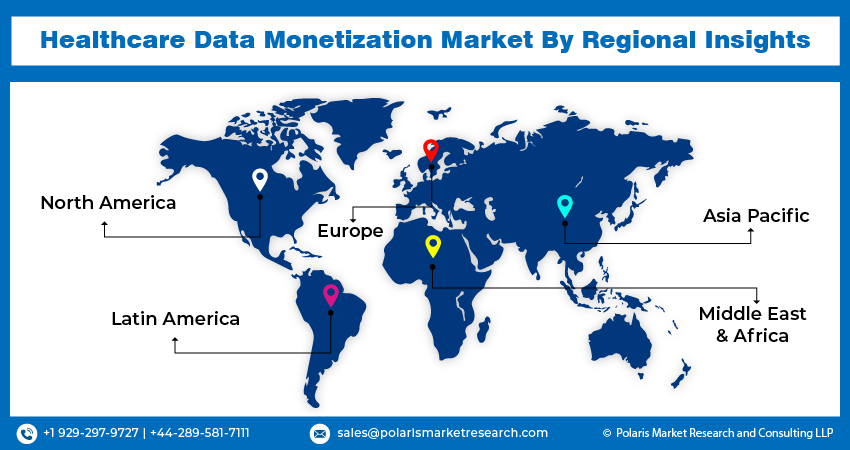
Healthcare Data Monetization Market Share, Size, Trends, Industry Analysis Report, By Method (Insight as a service, Data as a service, Analytics enabled platform as a service, Embedded Analytics); By Organization Size; By End-User; By Region; Segment Forecast, 2024 - 2032
- Published Date:Jan-2024
- Pages: 119
- Format: PDF
- Report ID: PM4071
- Base Year: 2023
- Historical Data: 2019-2022
Report Outlook
The global healthcare data monetization market was valued at USD 487.23 million in 2023 and is expected to grow at a CAGR of 19.30% during the forecast period.
Healthcare Data Monetization refers to the process of generating revenue or extracting value from the vast amounts of data collected and stored within the healthcare industry. This data can include electronic health records (EHRs), clinical notes, medical images, patient demographics, billing information, and more.

To Understand More About this Research: Request a Free Sample Report
The healthcare data monetization market is experiencing significant growth owing to the increasing usage of Electronic Health Records (EHRs) and the rising investments from both public and private sectors in advanced analytics solutions. The need to reduce healthcare-related expenses and the rapid digital transformation within the healthcare industry are also contributing to the market's expansion.
- For instance, In November 2022, Wipro Limited introduced the Wipro Data Intelligence Suite, an all-encompassing cloud solution aimed at aiding its clients in capitalizing on their data and modernizing their businesses via its cloud platform, thereby contributing to the expansion of the market.
Upgrading in cutting-edge technologies like Artificial Intelligence, Blockchain, big data analytics, Machine Learning (ML), and cloud computing is essential in propelling the expansion of data monetization within the healthcare sector. Data monetization tools and services empower pharmaceutical, healthcare, and medical technology firms to extract valuable insights, thus fueling their business advancement. Furthermore, these software and services are significant in enhancing the operational efficiency of various business models by forecasting potential risks and irregularities, thereby fostering growth within the healthcare data monetization market.
The COVID-19 pandemic has significantly impacted the healthcare data monetization market. While the pandemic has shown how important healthcare data is in managing public health crises, it has also presented challenges and opportunities for data monetization. On the one hand, the urgent need for real-time data and analytics to track and respond to the virus has accelerated data-sharing initiatives, fostering collaboration between healthcare organizations, governments, and private sector players. This has facilitated the growth of data monetization as more stakeholders seek to leverage and commercialize their healthcare data assets. On the other hand, concerns around patient privacy and data security have been heightened during the pandemic, leading to increased regulatory scrutiny and the need for robust data governance frameworks. Overall, the pandemic has catalyzed the transformation of the healthcare data monetization market, emphasizing the importance of responsible data handling and the potential for data-driven innovations to improve healthcare outcomes.
The growing utilization of Infrastructure-as-a-Service (IaaS) and Software-as-a-Service (SaaS) is opening up significant prospects for market participants to strengthen and expand their offerings in data monetization software and services.

Industry Dynamics
Growth Drivers
- Increasing acceptance of Electronic Health Records (Ehrs) will drive the market growth
The rising adoption of Electronic Health Records (Ehrs) is anticipated for the growth of the market. The increasing adoption of Electronic Health Records (EHRs) in healthcare has created new opportunities for data monetization. EHRs contain a wealth of valuable patient information. With proper privacy safeguards, this data can be leveraged by healthcare organizations and researchers for various purposes, such as clinical research, predictive analytics, and targeted marketing. The monetization of EHR data can not only generate revenue but also improve patient care, treatment outcomes, and healthcare system efficiency. However, it's essential to prioritize patient data security and privacy to build and maintain trust in this evolving landscape.
EHRs generate healthcare data that can be used by pharmaceutical companies, researchers, and insurers. This data can help identify potential trial participants, track drug effectiveness, refine risk assessment models, and gain insights into disease prevalence and patient populations. As EHR adoption increases, the healthcare data monetization market is expected to grow, creating new revenue opportunities.
Report Segmentation
The market is primarily segmented based on method, organization size, and end-user, and region.
|
By Method |
By Organization Size |
By End-User |
By Region |
|
|
|
|
To Understand the Scope of this Report: Speak to Analyst
By Method Analysis
- The Analytics-enabled platform as a service segment held the largest revenue share in 2022
The Analytics-enabled platform as a service segment held the largest revenue share. The expansion of Analytics-enabled platform services is due to the increasing need within various healthcare organizations to gauge the consistency of data patterns. This heightened demand has spurred a greater emphasis on enhancing their computational and statistical capabilities. Furthermore, the rising adoption of analytical solutions for demand sensing in the pharmaceutical industry plays a pivotal role in driving the growth of data monetization in the healthcare market segment. Within the pharmaceutical sector, demand sensing is widely employed to identify potential product consumers. This assists retailers in comprehending consumer behavior and its implications for the overall supply chain.
On the other hand, the embedded analytics segment is expected to witness fastest growth throughout the forecast period. Embedded analytics provides application users with the power to analyze collected data, enabling data-driven decision-making. These analytical tools play a pivotal role in enhancing customer engagement for healthcare organizations. Furthermore, embedded analytics is witnessing a significant surge in demand from both small and medium-sized enterprises (SMEs) and large corporations due to its comprehensive features, including data analysis, data visualization, data reporting, and data management.
By End-User Analysis
- The pharmaceutical and biotechnology segment accounted for the highest market share during the forecast period
The pharmaceutical and biotechnology segment accounted for the highest market share during the forecast period. The pharmaceutical and biotechnology sector includes pharmaceutical and biotechnology companies, as well as contract research and manufacturing organizations. Pharmaceutical companies play a critical role in the healthcare industry and can greatly benefit from access to comprehensive health data. This data is essential in helping to make informed decisions, determining research priorities, and gaining insights into the potential growth of specific medications.
On the other hand, healthcare players segment is anticipated to experience fastest growth throughout the forecast period. Healthcare players are increasingly comprising data monetization solutions to advantage of patient data, information from wearable devices, and payment transactions for financial gains. Additionally, the growing awareness of data analytics solutions within the healthcare sector is spurring the demand for data monetization tools. As businesses actively pursue digital transformation initiatives, innovative methods of sharing data while preserving privacy are slowly emerging, thus nurturing a promising outlook for data monetization in the healthcare industry.

Regional Insights
- North America dominated the largest market in 2022
North America dominated the largest market contributor in the healthcare data monetization market. The North American healthcare industry is experiencing significant growth in data monetization, driven by the continuous evolution of big data analytics and ongoing digital transformation. The U.S. government's emphasis on promoting digitization across various sectors to improve process transparency is also facilitating substantial opportunities for data monetization within the healthcare field.
The healthcare analytics market in North America is experiencing rising attention on population health management, substantial investments from venture capitalists, rising demands to reduce healthcare expenditures, technological progress, and a wide array of available products and services. Additionally, a majority of the key industry players in healthcare analytics are headquartered in North America.
The Asia Pacific region is accounted for the fastest growth. The rising utilization of cloud computing, the increasing integration of AI, and substantial investments in data centers by major industry players are optimistic factors for market growth. Furthermore, the expanding availability of healthcare services and the growing commitment of healthcare companies to implementing data management solutions in the region are anticipated to drive market expansion in the forecast period.

Key Market Players & Competitive Insights
The market is characterized by intense competition, with established players relying on advanced technology, high-quality products, and a strong brand image to drive revenue growth. These companies employ various strategies such as research and development, mergers and acquisitions, and technological innovations to expand their product portfolios and maintain a competitive edge in the market.
Some of the major players operating in the global market include:
- Accenture Plc
- H1
- Infor
- Informatica Inc.
- Infosys Limited
- Innovaccer, Inc.
- Microsoft Corporation
- OpenText Corporation
- Oracle Corporation
- Salesforce, Inc.
- SAP SE
- SAS Institute Inc.
- Siemens
- TIBCO Software Inc.
- Virtusa Corp
Recent Developments
- In April of 2023, Microsoft Corporation and Epic Systems joined forces to incorporate generative AI technology into the field of healthcare. This initiative involved the integration of Azure OpenAI Service with Epic's electronic health record (EHR) software, with the overarching goal of elevating patient care standards, boosting operational efficiency, and enhancing the financial stability of healthcare systems on a global scale.
- In April 2023, Salesforce unveiled its latest offering, Customer 360 for Health, designed to elevate individualized patient interactions and streamline operational expenses for healthcare providers. These cutting-edge features harness the power of real-time data, artificial intelligence, and automation to tackle the issues healthcare organizations encounter in meeting customer demands.
- In February 2023, Redox joined forces with Google Cloud to streamline the healthcare data exchange process, enhancing the capacity for quicker and more informed decision-making within the healthcare sector. Google Cloud would host a replica of Redox's platform, granting customers access to Redox's suite of products and services.
- In October 2022, Oracle launched a planning solution tailored for healthcare organizations. The solution is integrated into their Fusion Cloud EPM suite and helps improve financial performance and patient care outcomes through scenario simulation and resource optimization.
Healthcare Data Monetization Market Report Scope
|
Report Attributes |
Details |
|
Market size value in 2024 |
USD 578.35 million |
|
Revenue forecast in 2032 |
USD 2,370.63 million |
|
CAGR |
19.30% from 2024 – 2032 |
|
Base year |
2023 |
|
Historical data |
2019 – 2022 |
|
Forecast period |
2024 – 2032 |
|
Quantitative units |
Revenue in USD million and CAGR from 2024 to 2032 |
|
Segments Covered |
By Method, By Organization Size, By End-User, By Region |
|
Regional scope |
North America, Europe, Asia Pacific, Latin America; Middle East & Africa |
|
Customization |
Report customization as per your requirements with respect to countries, region and segmentation. |
